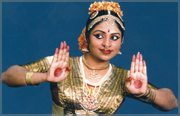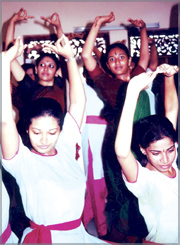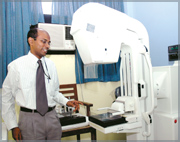|
dailynews |
|
|
|
|
|
OTHER LINKS |

|

|

|
|
Vasugy; dancing to a divine rhythmIt was an existential representation of Lord Shiva's dance of dynamism. They were all in traditional Indian attire; some in salwar khamiz and others in simple wide bordered cotton sarees.
Their tender hands, feet and eyes synchronised in a rhythmic language to address the cosmos and divine powers as art bridged the gap between the mortal and the divine. Their beloved guru shows that divine path to reach the gates of heaven by guiding them and perfecting the art. Kalasuri Vasugy Jagatheesan who is blessed with the language of God, Bharathanatyam, which is known as the fifth Veda is gladly imparting the art and tradition to her disciples to take the art forward. The beautiful art form bestowed on her by her mother, renowned Bharathanatyam artiste Vijayalakshmi Shanmugapillai began to enliven her at the tender age of three. Vasugy put her steady steps in dancing at the age of six and held her arangetram (initial stage performance) in 1976. Natya Kala Mandram, the dancing school run by Vijayalakshmi for nearly 23 years was handed over to Vasugy with a slight change in its name to Natya Kalamandir. "Mother being a well established dancer, I always wanted to be a dancer but never thought of becoming a dancing guru," she says.
Vasugy was born to a gifted family as not only her mother but father too is a super grade artiste in Mrudangam (a type of oriental drums) at the Sri Lanka Broadcasting Corporation. Her elder sister has also mastered dancing while her two brothers learnt music. In the course of 30 years, she has conducted 78 arangetram, 50 dance dramas and many national level programmes. The specialty of her dance is the fusion of Sinhalese and Tamil traditions to bring about a Sri Lankan flavour. "I don't teach a particular group of students. All of my students belong to various ethnic communities. Dance is all about harmony, so I highlight that diversity and harmony in the art too." She has brought Gajaga Wannama in the Sinhala tradition and Gajaga Vandanam in the Indian classical dance, together. According to her, both forms have similar features although techniques could be different. "In Bharatnatyam, hand movement and bhavam (facial expressions) are very important as it is choreography with drama whereas Kandyan dance is set to rhythmic patterns," she explains. For the last 30 years she has taught over 1,000 students. Art cannot be commercialised as it is divine. Since she speaks all three main languages, she can explain the bhavam (expressions) to all her students which is a key to a good output, she says. When she was 19, Vasugy went to Madras to master the art under Padmasri Adyar K. Lukshmanan and Kalamamani S.K. Rajaratnampillai. She completed a Diploma in Barathanatyam and came back to Sri Lanka to bestow her knowledge to others. Vasugy Jagatheesan and her students have made national as well as international level performances. Her performances were sought for Independence Day celebrations and many other national level programmes while she also performed at the SAARC Conference, Dhaka in 1985, Expo 86 Vancouver in Canada, Tamil Conference in Kuala Lumpur and many other cities such as Toronto, Calgary, Durban, Chennai and Bangalore. The Government in recognition of her talent and contribution conferred the prestigious 'Kalasuri' award in 1990 and later the title 'Bharatha Bhooshana Thilakam'. Then she was awarded many titles here and abroad and the latest is the 'Naadana Kalai Arasi' by renowned Indian artiste Dr. Padma Subramaniam in August this year. She was a dance instructor at Sarasavipaya, Indian Cultural Centre and Holy Family Convent, Bambalapitiya. "The support I get from my family is vital in this journey," she says. Her husband is an ardent admirer and a supporter of the art and his cooperation is the major strength of her success, she adds. Her 13 year-old-son is also mastering Karnatic music and Mrudangam. "Along with talent, my dedication and hard work has brought me so far. I never see the time when I work. But I always spend my free time with the family," Vasugy says. The annual dance extravaganza organised by Vasugy with her students will be held on October 14 at the BMICH. "This time it's a landmark of my dancing life as I celebrate the 30th year," she adds as she prepares to immerse herself in the divine tradition with her students. ################# A lesson from LALESSON: This year I had the fortune of spending a summer vacation in Los Angeles California. Los Angeles is undoubtedly one of the most beautiful places in the world. My husband and I had the habit of going for walks after our morning tea whenever we could make it. The climate at this time in the morning was very refreshing and the cool breeze was very comforting. Something that I noticed during my walks was the sheer cleanliness of the roads. The workers from the municipality do a great job every morning cleaning up the entire place with their massive equipment - grasscutters, blowers etc. They had allocated specified days for different sectors. Domestic garbage is sorted out at the household itself making the sorting out a simple process. Americans are very civic conscious and take pride in keeping the surroundings clean and tidy. Many American people take their pet dogs on a stroll in the morning. We came across sign boards on the road saying, 'Be kind to your neighbours, curb your dog', 'Put dog waste into a bin and that is just what they do. they always carry a square polythene bag in their pocket put their hand into it, take up the dog waste (whenever the dog relieves itself) and put it into the big dustbins by the roadside. As a result, the roads are very clean and we can walk into our home without any dirt on our shoes. Furthermore the trees and greenery that are cut, are shredded at the premises itself before being loaded to the collection truck. The bins on the roadside and household garbage are mechanically hauled into the garbage truck. The efforts taken by Americans to keep their national natural reserves, parks etc. clean and orderly is truly very commendable. The National Environment Week in Sri Lanka is October 1-7. It is heartening to see that our President, Mahinda Rajapaksa is guiding the cleaning campaign. We women could greatly help this endeavour by cleaning our domestic garbage efficiently, teaching children and helpers the value of cleanliness and generally taking an active part. Let us make this beautiful island 'The Pearl of the Indian Ocean', a really beautiful country. #################### Breast Cancer: Early detection key to cureBreast cancer is the commonest form of cancer among Sri Lanka women. It affects both the rich and the poor alike. Breast cancer is difficult to prevent but can be treated effectively if diagnosed early. Q: What is a cancer?
A: It is an uncontrolled division of abnormal cancer cells. Initially a single cell undergoes a change due to a genetic or an environmental cause. This cell multiplies and becomes what we call a cancer. A cancer has the ability to spread to other parts of the body by local extension through the lymph or through blood. Q: What is the difference between breast cancer and other cancers? A: It is the commonest cancer among women in Sri Lanka and worldwide. Also it is a cancer where early detection gives a good prospect for curing. Q: What are the genes causing breast cancer? A: There are three well-known genes called BRCA1, BRCA2 and P53. Everybody has these genes and a mutation of one of these is likely to result in a cancer. Q: Is there any links to the other cancers? A: Yes, there is link to ovarian cancer as well as womb and bowel cancer. Q: What are the risk factors for breast cancer?
A: Age is a risk factor. As a person grows older the risk of developing a cancer becomes higher. Another important risk factor is a family history of breast cancer. Early menarche, late menopause and the use of estrogens as contraceptives or as hormone replacement are other risk factors. Women who don't have children and women who have their first child after the age of 35 also have a higher risk of developing breast cancer. Q: What are the protective factors for breast cancer? A: Breast feeding is considered protective. Having children early in life is also beneficial. Q: How to minimise risk factors? A: Most of the risk factors I have mentioned above cannot be modified. Therefore the most important thing is early detection. That is why we suggest that women over 40 years should undergo a Mammogram and Ultrasound Scan once every two to three years to detect a cancer in its early stage. Q: When to consult a doctor? A: We recommend all women should examine their breasts about once a month soon after the menstrual periods. If you feel a lump or doubt whether you have a lump then you should consult a doctor. The second thing is to notice if there is a discharge from the nipple especially a blood stained discharge. Rarely a woman may notice a red coloured eczema in one nipple. These are early warning signs of breast cancer. Q: What would be the medical advice? A: Consult a surgeon if you notice any of these changes in your breast(s). The doctor will make a diagnosis and assess the spread before deciding on treatment. Q: What is the procedure? A: Our practice is triple assessment. The first is examination of the patient by a doctor. Next is ageing, which means mammogram and ultra sound scan. Mammogram is a special soft tissue X-ray of the breast. A needle biopsy using a very fine needle usually confirms the diagnosis. It is a painless procedure and does not require any anaesthesia. Q: What are the types of breast cancer? A: The commonest is duct carcinoma. Lobular carcinoma, Mucoid carcinoma and inflammatory carcinoma are less common. Q: What will be the prognosis of a breast cancer generally? A: It would depend on several factors. The type of cancer, the grade of the cancer cells and the extent of the cancer spread at the time of diagnosis. Q: What are the chances of recurrence after treatment ? A: Unfortunately, this is a cancer that can recur even 10 years after treatment. In general the risk of recurrence is less if it is diagnosed early and treated adequately. Early detection saves lives. |













